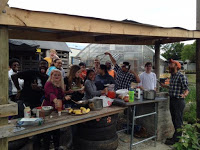Teacher learns food literacy is more than teaching about healthy food; it’s also about geographic and socioeconomic challenges

 |
| Cooking Club, part of Fern Creek’s Food Literacy class (Photo by Joe Franzen) |
A “food literacy” class that began as a way to teach high-school students to eat healthier has turned into a social-justice exploration through the shared language of food preparation and eating, Joe Franzen writes in a “Classroom Connection” piece for The Courier-Journal.
Franzen, a food and sustainability educator at Fern Creek High School in Jefferson County, said he showed up to his first food-literacy class at FCHS with plans to teach about “healthy” foods, new and improved cooking techniques and how to grow a garden.
“My students balked,” he wrote, saying they pushed back on his curriculum with real-world issues that screamed of the geographic and socioeconomic realities that often segregate people into those who can afford to eat “healthy” and have access to fresh, healthy foods and those who can’t and don’t.
“They complained of not having the tools to cook at home or the ability to purchase ingredients on a budget.They explained how apartments don’t have yards to dig up.They talked about how junk food tastes good,” he wrote.
So Franzen said he shifted the focus of the class, realizing that it would have to deal with the “dynamic realities” of his students.
Franzen noted that one of the first changes he implemented was to ask his students: “What is your food reality? What is your definition of ‘good’ food? What are the recipes that your family values? What are the boundaries that you face in eating well?”
Which, he said, led to “student-written food narratives, lessons in food discourse and debate, class cookbooks, 30-student potlucks, and conversations about what people deserve, what is just and right — all while using our city as a classroom, textbook, and laboratory to explore and critically engage.”
And all of this led to “talking about socioeconomic status, income inequality, privilege, race, religion, gender, and ethnicity,” he wrote. “All I started out wanting to do was teach a couple of recipes, encourage less soda consumption, and show how to put a plant in a hole.”
Franzen said he was “glad that students sent back the first version of ‘food literacy’ and that the new curriculum now formally “looks like Food Lit., a food-themed pre-AP English course, Cooking Club, Food Sociology, Global Issues, and Environmental Club.”
“Through this process, I realized what good teaching should be: responding to the needs and curiosities of the students to help them critically engage and question the world in a way that allows them to improve themselves and the community around them,” he wrote.
He wrote: Food literacy “isn’t just about eating “healthy” or learning to cook, it is about building community and building resiliency within ourselves and together during such divisive times.”